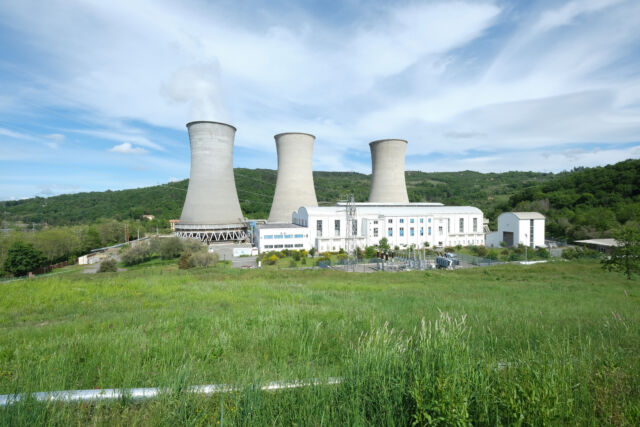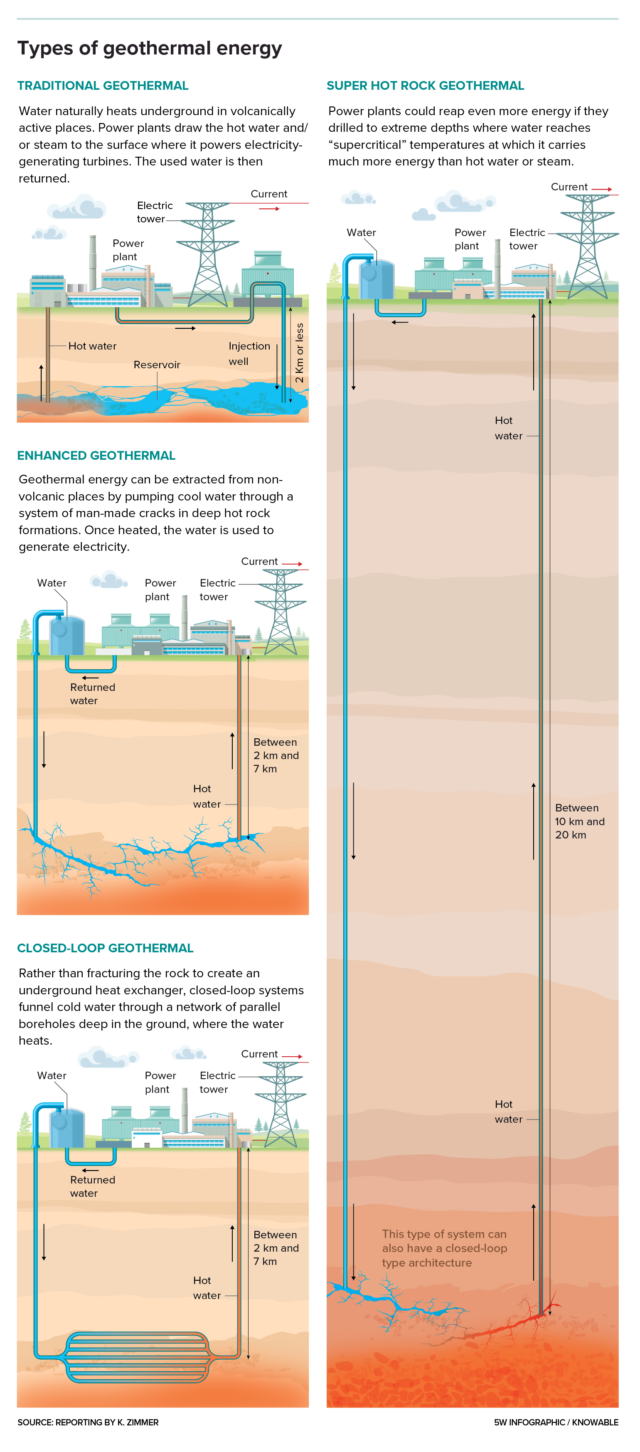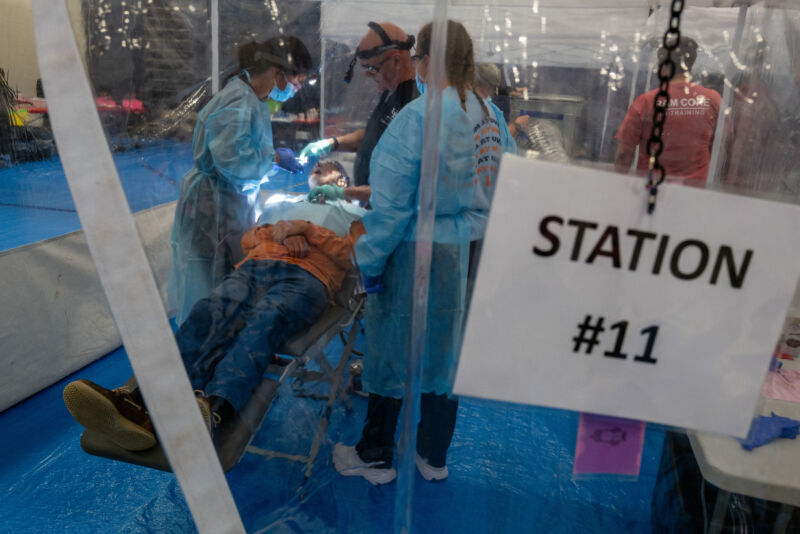
Click here to go see the bonus panel!
Hovertext:
The silver lining is due to cesium contamination.
Today's News:

Hovertext:
The silver lining is due to cesium contamination.













The post How Ford Could Attack The Electric Dodge Charger With A Mustang That’s Not A Mustang appeared first on The Autopian.

Enlarge / The Nesjavellir Geothermal Power Station. Geothermal power has long been popular in volcanic countries like Iceland, where hot water bubbles from the ground. (credit: Gretar Ívarsson/Wikimedia Commons)
Glistening in the dry expanses of the Nevada desert is an unusual kind of power plant that harnesses energy not from the sun or wind, but from the Earth itself.
Known as Project Red, it pumps water thousands of feet into the ground, down where rocks are hot enough to roast a turkey. Around the clock, the plant sucks the heated water back up to power generators. Since last November, this carbon-free, Earth-borne power has been flowing onto a local grid in Nevada.
Geothermal energy, though it’s continuously radiating from Earth’s super-hot core, has long been a relatively niche source of electricity, largely limited to volcanic regions like Iceland where hot springs bubble from the ground. But geothermal enthusiasts have dreamed of sourcing Earth power in places without such specific geological conditions—like Project Red’s Nevada site, developed by energy startup Fervo Energy.
Such next-generation geothermal systems have been in the works for decades, but they’ve proved expensive and technologically difficult, and have sometimes even triggered earthquakes. Some experts hope that newer efforts like Project Red may now, finally, signal a turning point, by leveraging techniques that were honed in oil and gas extraction to improve reliability and cost-efficiency.
The advances have garnered hopes that with enough time and money, geothermal power—which currently generates less than 1 percent of the world’s electricity, and 0.4 percent of electricity in the United States—could become a mainstream energy source. Some posit that geothermal could be a valuable tool in transitioning the energy system off of fossil fuels, because it can provide a continuous backup to intermittent energy sources like solar and wind. “It’s been, to me, the most promising energy source for a long time,” says energy engineer Roland Horne of Stanford University. “But now that we’re moving towards a carbon-free grid, geothermal is very important.”
Geothermal energy works best with two things: heat, plus rock that is permeable enough to carry water. In places where molten rock sizzles close to the surface, water will seep through porous volcanic rock, warm up and bubble upward as hot water, steam, or both.
If the water or steam is hot enough—ideally at least around 300 degrees Fahrenheit—it can be extracted from the ground and used to power generators for electricity. In Kenya, nearly 50 percent of electricity generated comes from geothermal. Iceland gets 25 percent of its electricity from this source, while New Zealand gets about 18 percent and the state of California, 6 percent.
Some natural geothermal resources are still untapped, such as in the western United States, says geologist Ann Robertson-Tait, president of GeothermEx, a geothermal energy consulting division at the oilfield services company SLB. But by and large, we’re running out of natural, high-quality geothermal resources, pushing experts to consider ways of extracting geothermal energy from areas where the energy is much harder to access. “There’s so much heat in the Earth,” Robertson-Tait says. But, she adds, “much of it is locked inside rock that isn’t permeable.”

The Lardarello plant in the Tuscany region of Italy was the first geothermal power plant in the world. It was completed in 1913. (credit: Francesco Lorenzetti via Getty Images)
Tapping that heat requires deep drilling and creating cracks in these non-volcanic, dense rocks to allow water to flow through them. Since 1970, engineers have been developing “enhanced geothermal systems” (EGS) that do just that, applying methods similar to the hydraulic fracturing—or fracking—used to suck oil and gas out of deep rocks. Water is pumped at high pressure into wells, up to several miles deep, to blast cracks into the rocks. The cracked rock and water create an underground radiator where water heats before rising to the surface through a second well. Dozens of such EGS installations have been built in the United States, Europe, Australia, and Japan—most of them experimental and government-funded—with mixed success.
Famously, one EGS plant in South Korea was abruptly shuttered in 2017 after having probably caused a 5.5-magnitude earthquake; fracking of any kind can add pressure to nearby tectonic faults. Other issues were technological—some plants didn’t create enough fractures for good heat exchange, or fractures traveled in the wrong direction and failed to connect the two wells.
Some efforts, however, turned into viable power plants, including several German and French systems built between 1987 and 2012 in the Rhine Valley. There, engineers made use of existing fractures in the rock.
But overall, there just hasn’t been enough interest to develop EGS into a more reliable and lucrative technology, says geophysicist Dimitra Teza of the energy research institute Fraunhofer IEG in Karlsruhe, Germany, who helped develop some of the Rhine Valley EGS systems. “It has been quite tough for the industry.”

Geothermal electricity has long been limited to volcanic regions where underground heat is easily accessible. But new kinds of power plants are making it possible to derive geothermal heat elsewhere in the world. (credit: Knowable Magazine (CC BY-ND))
Solutions exist for both safety and technological problems. There are, in fact, robust protocols for avoiding earthquakes, such as by not drilling near active faults. Long-term monitoring of the operating EGS plants in France and Germany has documented only minor tremors, building confidence in the safety of the technology. Importantly, drilling and fracking methodology has improved by leaps and bounds, thanks to the boom in oil and gas extraction from shale rocks that began in the 2010s. “Since then, we’ve seen a renewed interest in EGS as a concept, because the techniques that are central to EGS were perfected and brought down significantly in cost during that time,” says Wilson Ricks, an energy systems researcher at Princeton University.
In 2015, for instance, the US Department of Energy launched a research site in Utah dedicated to advancing EGS technologies. Several new North American startups, including Sage Geosystems and E2E Energy Solutions, are developing new EGS systems in Texas and Canada, respectively. The most advanced is Fervo Energy, which has applied several techniques from the shale industry at its Nevada plant, which now supplies a local grid that includes energy-sucking data storage centers owned by Google. (Google partnered with Fervo to develop the plant.)
Engineers drilled almost 8,000 feet downward into the Nevada rock, reaching temperatures of nearly 380 degrees Fahrenheit, and then, at the bottom, drilled another 3,250-foot horizontal well to expand the area of hot rock that the system touches—a technique used in oil and gas extraction in order to maximize yield. The company also fractured the surrounding rock at several sites along the horizontal well to create a more extensive web of cracks for water to trickle through. Technologically speaking, compared to earlier EGS efforts, “they are, in fact, a big step forward,” says Horne, who is on Fervo’s scientific advisory board.

A geothermal plant in Washoe County, Nevada. Startup Fervo Energy has been working on methods that could make geothermal a more widespread electricity source. (credit: Matt Mawson via Getty Images)
It remains to be seen how these new EGS systems perform in the long term. One advantage of systems like Fervo’s is that they can be made more profitable by taking advantage of energy price fluctuations, according to recent research by Ricks, a Princeton colleague and several experts at Fervo Energy. Operators could plug the exit wells, causing water to accumulate inside the system, building up pressure and heat. Then the energy could be extracted during times when it is most valuable—such as during cloudy or windless periods when solar or wind aren’t working.
Still, such systems would have to be significantly scaled up to be commercially viable, Ricks says. Although Project Red claims a larger capacity than any other EGS plant—3.5 megawatts, enough to power more than 2,500 homes—it’s still relatively small; a nuclear or coal plant can easily have an output of 1,000 megawatts, while large solar or traditional geothermal plants often produce several hundred megawatts.
What the EGS field needs right now, Ricks says, is the funding to build and test more such systems to inspire investor confidence. “This all needs to be very well proven, out to the point where the perceived risk is low,” he says.
To that end, the US Department of Energy recently awarded $60 million in funding to three demonstration projects for EGS and related technologies as part of a broader initiative to speed up EGS development. One 2019 report from the agency estimated that, with advances in EGS, geothermal power could represent around 60 gigawatts (60,000 megawatts) of installed capacity in the United States by 2050, generating 8.5 percent of the country’s electricity—a more-than-20-fold increase from today.
Even an increase of a few percent could aid in a global energy transition that’s aiming to get to net zero carbon emissions by 2050. “If in fifteen, twenty years, EGS is viable, I think it could play a huge part,” says Nils Angliviel de La Beaumelle, who recently coauthored an article on the global outlook for renewable energy in the Annual Review of Environment and Resources.
Other geothermal technologies may also help. Some companies are exploring the feasibility of “super hot rock” geothermal—essentially, a young, extreme variant of EGS that involves drilling down even deeper into Earth’s crust, to a depth where water reaches a “supercritical” vapor-like state that allows it to carry much more energy than either steam or liquid. In southern Germany, the energy company Eavor is building the world’s first “closed-loop” geothermal system: Once pipes funnel water into the deep rock, the system fans out into a network of parallel boreholes, without water ever penetrating the rock. That’s a more predictable—albeit less efficient—way of warming water, as it doesn’t involve uncertainties around fracturing the rock in the right way, Teza says. “I’m really excited to see that there’s investment into these technologies,” she says. “I think it can only help.”
On the whole, it’s an important moment for geothermal energy—and not just for providing carbon-free electricity, Robertson-Tait says. Geothermal brines hauled out of the Earth are rich in lithium and other critical minerals that can be used to build green technologies like solar panels and EV batteries. There’s a growing push to use direct geothermal heat to warm buildings, either through shallow heat pumps for residential buildings or larger systems designed for entire districts—like Paris and Munich already have.
Some oil and gas companies, recognizing that a change is coming, are increasingly interested in building geothermal systems of various kinds, says Robertson-Tait. “Our Earth is geothermal,” she says, “and so I think we owe it to ourselves to do everything we can to use it.”
This article originally appeared in Knowable Magazine, a nonprofit publication dedicated to making scientific knowledge accessible to all. Sign up for Knowable Magazine’s newsletter.

Enlarge / Dental students, working as volunteers, attend to patients at a Remote Area Medical (RAM) mobile dental and medical clinic on October 7, 2023 in Grundy, Virginia. More than a thousand people were expected to seek free dental, medical and vision care at the two-day event in the rural and financially struggling area of western Virginia. (credit: Getty | Spencer Platt)
In the 1960s and 1970s, people who lived in rural America fared a little better than their urban counterparts. The rate of deaths from all causes was a tad lower outside of metropolitan areas. In the 1980s, though, things evened out, and in the early 1990s, a gap emerged, with rural areas seeing higher death rates—and the gap has been growing ever since. By 1999, the gap was 6 percent. In 2019, just before the pandemic struck, the gap was over 20 percent.
While this news might not be surprising to anyone following mortality trends, a recent analysis by the Department of Agriculture’s Economic Research Service drilled down further, finding a yet more alarming chasm in the urban-rural divide. The report focused in on a key indicator of population health: mortality among prime working-age adults (people ages 25 to 54) and only their natural-cause mortality (NCM) rates—deaths among 100,000 residents from chronic and acute diseases—clearing away external causes of death, including suicides, drug overdoses, violence, and accidents. On this metric, rural areas saw dramatically worsening trends compared with urban populations.

Change in age-adjusted, prime working-age, external- and natural-cause mortality rates for metro and nonmetro areas, 1999–2001 to 2017–2019. (credit: USDA)
The federal researchers compared NCM rates of prime working-age adults in two three-year periods: 1999 to 2001, and 2017 to 2019. In 1999, the NCM rate in 25- to 54-year-olds in rural areas was 6 percent higher than the NCM rate of this age group in urban areas. In 2019, the gap had grown to a whopping 43 percent. In fact, prime working-age adults in rural areas was the only age group in the US that saw an increased NCM rate in this time period. In urban areas, working-age adults' NCM rate declined.
Broken down further, the researchers found that non-Hispanic White people in rural areas had the largest NCM rate increases when compared to their urban counterparts. Among just rural residents, American Indian and Alaska Native (AIAN) and non-Hispanic White people registered the largest increases between the two time periods. In both groups, women had the largest increases. Regionally, rural residents in the South had the highest NCM rate, with the rural residents in the Northeast maintaining the lowest rate. But again, across all regions, women saw larger increases than men.

Age-adjusted prime working-age natural-cause mortality rates, metro and nonmetro areas, 1999–2019. [credit: USDA ]
Among all rural working-age residents, the leading natural causes of death were cancer and heart disease—which was true among urban residents as well. But, in rural residents, these conditions had significantly higher mortality rates than what was seen in urban residents. In 2019, women in rural areas had a mortality rate from heart disease that was 69 percent higher than their urban counterparts, for example. Otherwise, lung disease- and hepatitis-related mortality saw the largest increases in prevalence in rural residents compared with urban peers. Breaking causes down by gender, rural working-age women saw a 313 percent increase in mortality from pregnancy-related conditions between the study's two time periods, the largest increase of the mortality causes. For rural working-age men, the largest increase was seen from hypertension-related deaths, with a 132 percent increase between the two time periods.

Nonmetro age-adjusted, prime working-age mortality rates by sex for 15 leading natural causes of death, 1999–2001 and 2017–2019, as percent above or below corresponding metro rates. (credit: USDA)
The study, which drew from CDC death certificate and epidemiological data, did not explore the reasons for the increases. But, there are a number of plausible factors, the authors note. Rural areas have higher rates of poverty, which contributes to poor health outcomes and higher probabilities of death from chronic diseases. Rural areas also have differences in health behaviors compared with urban areas, including higher incidences of smoking and obesity. Further, rural areas have less access to health care and fewer health care resources. Both rural hospital closures and physician shortages in rural areas have been of growing concern among health experts, the researchers note. Last, some of the states with higher rural mortality rates, particularly those in the South, have failed to implement Medicaid expansions under the 2010 Affordable Care Act, which could help improve health care access and, thus, mortality rates among rural residents.

Twenty-six years ago today, Deep Space Nine delivered the knife under its cloaked examination of Star Trek’s morals in wartime with all the delicate precision of a sewing needle: the incredible “In the Pale Moonlight,” not just one of DS9 or Star Trek’s finest hours, but one of the all time greatest episodes of TV ever made. But the finest moment in an already immaculate piece of television is all about the ways to enact violence without lifting a single finger.
“In the Pale Moonlight,” framed around a maudlin Captain Sisko recounting recent events in his personal log after a long, long day, is about the increasing moral compromises he is willing to make as one of Starfleet’s vanguards in the increasingly dire war against the Dominion. Seeing an opportunity to bring one of the Federation’s coldest enemies, the secretive Romulans, into a war they’ve stayed neutral in, Sisko finds himself drawn into the charismatic orbit of the simple tailor and occasionally master of all sorts of spycraft, Garak the Cardassian clothier, as the two plot to artificially construct evidence of a Dominion plot to invade the Romulan Star Empire, and pass it along to a Romulan senator.

The episode layers on its tension through each circle of hell Sisko is willing to put his soul through. Even the first step of simply working with Garak on such a plan is already heinous enough for the high and mighty values of Starfleet’s officer class, but bit by bit, Sisko begins to see the proverbial river of blood he must wade into to come out of the other side with even a chance of Romulus entering the Dominion War. Using criminals to fake evidence, crafting the perfect deception, planting it in Senator Vreenak’s hands, all this would be tantamount to the gravest of moral costs our hero could pay... and then it all blows up in his face when Vreenak calls Sisko out on his bluff, realizing the data rod he’s been handed showcasing the Dominion’s supposed plans is counterfeit.
It’d be here that any other Star Trek show would plant its flag as the lowest moment one of its heroes could sink to: they played dirty, and now must face the consequences of taking the low road. But Deep Space Nine is not any other Star Trek show, and so it prepares to thrust its knife. The next day, as senior staff monitor casualty lists and Sisko braces for his fall, a Starfleet Intelligence report comes through confirming the death of a Romulan Senator in a shuttlecraft explosion the Star Empire is laying at the hands of Dominion subterfuge. It’s Vreenak: he’s dead, the secret of Sisko’s moral cost with him, and Sisko knows exactly who’s to blame for the explosion.
As Sisko storms down to Garak’s shop, we get it: the finest moment in all of Deep Space Nine. Time and time again in the show, in ways small and large, we’ve seen up to this point that Benjamin Sisko is not a man who pulls punches, metaphorically or otherwise. From laying out Q the moment he tries to cast the then-Commander as another Picard, to his dogged determination to root out the anti-Cardassian guerrillas of the Maquis, Sisko has always acted as he does here: to come in swinging. He decks Garak, sending him clean across the room. He yells his accusations at Garak—he killed Vreenak, he killed the criminal they used to forge that data rod; all along, he’s knowingly brought the Romulans into the deadliest war the Alpha Quadrant has seen in generations on a falsehood. Even without the punch, this isn’t Sisko passionate or dogged or determined. He is furious, something we have seen simmering in him before, but now fully unleashed.
But Garak never fights back. He takes Sisko’s punch, and all the rage, goes to block the second swing, but he doesn’t match Sisko’s braggadocio. He waits. And then in cold, calculating form, he turns Sisko on himself—laying out all the evidence that the Romulans will now have, from a dead senator to an imperfect, damaged rod containing even the faintest traces of evidence of a Dominion plot, and guides Sisko along the way to a conclusion that was there from the beginning of the episode. Sisko would see what Garak predicts the Romulans will see, and would enter the war against the Dominion, just as they will. Garak doesn’t even have to say it, he just lets Sisko work through it out loud himself, not even having to push him... because for all his posture, for all the fists swinging, they think exactly the same. And if anything, Sisko is even dirtier than that, because he already knew that in going to Garak he would get someone who willing to dirty their own hands on his behalf, and leave him with the victory he wanted—at any cost, no matter what he’d claim otherwise.
And so, with Sisko at the lowest depths of hell at last, he and Garak are locked as kindred spirits in this game of spycraft and moral theater. It’s a remarkable moment, one that has rightly stuck with Star Trek for the two and a half decades since it first broadcast, because of the way it skewers the franchise’s legacy of purported enlightenment in such an elegantly compelling way. For years before this, Starfleet and its officers have been depicted as above this kind of underhanded manipulation—that our heroes talk their ways out of fights, that they maintain the moral high ground, and that even when they falter, when they play a little dirty, it’s with a roguish charm, and in the manner of a hero, the small, innocent prices paid, for a greater good that is always worth it. It’s never meant to stain their soul, because in the end, it always works out in the hero’s favor—and their righteous view of the universe.
Sisko’s greater good is hundreds of thousands, if not millions, of beings slaughtered to prevent the complete destruction of the Alpha Quadrant powers as we know them, predicated on a lie. In the end, he got it, not in the noblest of manners as the heroes before him might have, but through cloak and dagger deception and knives in the dark. Because, back against the wall, he was always willing to throw that punch—and because Garak knew it too, he himself never had to.
Want more io9 news? Check out when to expect the latest Marvel, Star Wars, and Star Trek releases, what’s next for the DC Universe on film and TV, and everything you need to know about the future of Doctor Who.
Published on April 11, 2024

First, clarification: This is not Syfy’s Dark Matter. This is Apple TV+’s Dark Matter, which is not about a spaceship’s amnesiac crew, but about a guy who kidnaps himself from another reality. If you did not watch the other Dark Matter, this won’t be confusing at all. The rest of us will just suffer, mildly.
The new Dark Matter is based on the novel by Blake Crouch. It stars Joel Edgerton as Jason Dessen, who has a nice life with his wife (Jennifer Connelly) and son (Oakes Fegley). He does mysterious science work and seems happy enough, until one night he is abducted and wakes up in a world that’s very, very different.
The summary spells it all out:
Hailed as one of the best sci-fi novels of the decade, Dark Matter is a story about the road not taken. The series will follow Jason Dessen (played by Joel Edgerton), a physicist, professor and family man who — one night while walking home on the streets of Chicago — is abducted into an alternate version of his life. Wonder quickly turns to nightmare when he tries to return to his reality amid the mind-bending landscape of lives he could have lived. In this labyrinth of realities, he embarks on a harrowing journey to get back to his true family and save them from the most terrifying, unbeatable foe imaginable: himself.
The series also stars Westworld’s Jimmi Simpson and A Murder at the End of the World’s Alice Braga. Crouch himself is the series’ writer and showrunner—his third time working on an adaptation of his own work (he co-created Good Behavior with Chad Hodge, and was a writer for Hodge’s adaptation of Wayward Pines).
Get into the alternate-reality box on May 8th on Apple TV+. [end-mark]
The post Would You Like an Alternate Reality? The <i>Dark Matter</i> Trailer Has Plenty to Go Around appeared first on Reactor.